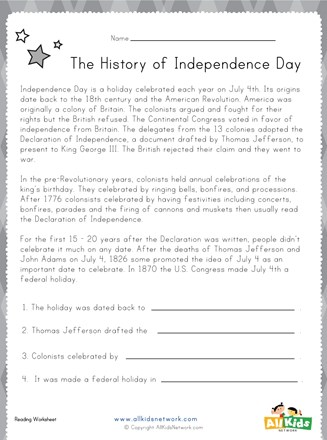The History Of Independence Day: Key Events And Figures

Table of Contents
The Road to Independence: Colonial Grievances and Growing Tensions
The years leading up to the Declaration of Independence were marked by escalating tensions between Great Britain and its thirteen American colonies. A series of events fueled colonial discontent and ultimately pushed the colonies towards revolution. The relationship, once relatively harmonious, deteriorated significantly due to a perceived imbalance of power and unfair treatment by the British crown. This period is crucial to understanding the context of the Declaration of Independence and the reasons behind the American Revolution.
-
Taxation without Representation: The British government implemented a series of taxes on the colonies without their consent or representation in Parliament. These included the Stamp Act (1765), the Townshend Acts (1767), and the Tea Act (1773), all of which sparked widespread protests and boycotts. These acts are considered major catalysts for the growing unrest.
-
The Intolerable Acts: In response to the Boston Tea Party, Great Britain passed the Intolerable Acts (1774), a series of punitive measures designed to subdue the rebellious colonies. These acts further inflamed tensions and solidified colonial unity against British rule. The acts included the closure of Boston Harbor and restrictions on town meetings.
-
Increasing Calls for Colonial Self-Governance: The oppressive measures implemented by the British government fueled calls for greater colonial autonomy and self-governance. Leaders emerged who championed the cause of independence, arguing for the colonies' right to govern themselves.
-
Key Figures: Samuel Adams, a fiery revolutionary and organizer, played a crucial role in galvanizing colonial resistance. Patrick Henry, known for his powerful oratory, delivered his famous "Give me liberty, or give me death!" speech, inspiring many to embrace the revolutionary cause. These figures embody the spirit of resistance that led to the declaration.
The Declaration of Independence: Drafting, Debate, and Adoption
The Declaration of Independence, drafted primarily by Thomas Jefferson, was a crucial document articulating the reasons for the colonies' separation from Great Britain. Its creation and adoption involved extensive debate and revision within the Continental Congress.
-
The Role of the Continental Congress: The Continental Congress, representing the thirteen colonies, played a pivotal role in drafting and adopting the Declaration. The Congress debated and revised the document, ensuring it represented the collective will of the colonies.
-
Key Arguments Presented: The Declaration powerfully argued for natural rights, including the rights to life, liberty, and the pursuit of happiness, principles that are foundational to American political thought. It asserted that governments derive their just powers from the consent of the governed.
-
Debate and Revisions: The process of drafting the Declaration was not without its challenges. Delegates debated the wording and scope of the document, making significant revisions before its final adoption. The final version reflects a compromise between different viewpoints within the Congress.
-
Significance of the Philosophical Underpinnings: The Declaration's philosophical underpinnings, deeply rooted in Enlightenment thought, had a profound impact on the course of history, influencing revolutionary movements around the world. The emphasis on natural rights and self-governance continues to resonate today. The signing of the Declaration on August 2nd, 1776, is often considered a more accurate date.
Key Figures of the American Revolution: Leaders and Visionaries
While Thomas Jefferson penned the Declaration, many other individuals played crucial roles in securing American independence. These figures provided military leadership, diplomatic expertise, and unwavering support for the revolutionary cause.
-
George Washington: Washington's leadership as Commander-in-Chief of the Continental Army was instrumental in uniting the colonies and securing victory in the Revolutionary War. His steadfastness and determination were vital to the success of the revolution.
-
Benjamin Franklin: Franklin's diplomatic skills were invaluable in securing international support for the American cause, particularly from France. His influence and wisdom helped shape the course of the revolution.
-
John Adams: Adams was a staunch advocate for independence and played a critical role in the Continental Congress. His contributions to the Declaration and his later role as a key figure in the early Republic should not be overlooked.
-
Other Notable Figures: John Hancock, whose bold signature is prominently displayed on the Declaration, and Abigail Adams, a significant figure in her own right, who advocated for women’s rights and corresponded with her husband throughout the revolution, are only two of many other individuals who contributed to the success of the revolution.
The Aftermath of Independence: War, Treaty, and Nation-Building
The Declaration of Independence was merely the first step in a long and arduous journey towards establishing a new nation. The newly declared nation faced numerous challenges in the years that followed.
-
The Revolutionary War: The Declaration ignited the Revolutionary War, a protracted conflict with Great Britain that tested the resolve and resilience of the newly formed nation. Key battles such as Saratoga and Yorktown proved pivotal in the eventual American victory.
-
The Treaty of Paris (1783): The Treaty of Paris formally recognized American independence and defined the boundaries of the new nation. This treaty marked the official end of the war and the beginning of a new era for the United States.
-
The Articles of Confederation and its Limitations: The Articles of Confederation, the first governing document of the United States, proved to be inadequate for the challenges facing the new nation. Its weaknesses led to the eventual drafting and adoption of the United States Constitution.
-
Early Struggles: The early years of the new nation were fraught with challenges, including economic instability, territorial disputes, and internal conflicts. The creation of a stable and functioning government was a monumental task.
Independence Day Celebrations: Then and Now
Independence Day celebrations have evolved significantly since the 18th century. Early celebrations were more subdued compared to the extravagant festivities of today.
-
Early Celebrations: Early celebrations were often characterized by local events, speeches, and community gatherings. The focus was on commemorating the adoption of the Declaration and celebrating newfound freedom.
-
Emergence of Key Traditions: Over time, traditions such as fireworks displays, parades, and picnics emerged, becoming integral parts of Independence Day celebrations. These traditions continue to evolve and adapt over time.
-
Modern Celebrations: Modern celebrations are diverse and reflect the country's multicultural character. Celebrations range from large-scale public events to intimate family gatherings.
-
Global Celebrations: Independence Day is not just celebrated in the United States; its significance is felt globally. Many countries with ties to the United States also acknowledge the occasion in various ways.
Conclusion
Independence Day is more than just a holiday; it's a commemoration of a pivotal moment in history, a testament to the courage and determination of those who fought for freedom and self-governance. From the escalating tensions with Great Britain to the drafting and adoption of the Declaration, and the subsequent Revolutionary War, the journey to independence was arduous and transformative. Understanding the history of Independence Day allows us to appreciate the sacrifices made and the enduring principles upon which the United States was founded. The key figures and events surrounding this important date continue to shape our national identity.
Call to Action: Learn more about the rich history of Independence Day and the courageous individuals who shaped this pivotal moment. Explore the historical documents, delve deeper into the lives of the key figures, and continue to celebrate this important milestone in American history. Further your understanding of Independence Day events and figures by exploring the numerous resources available online and in libraries.

Featured Posts
-
 X Stiven King Zrobiv Guchni Zayavi Pro Trampa Ta Ilona Maska
May 06, 2025
X Stiven King Zrobiv Guchni Zayavi Pro Trampa Ta Ilona Maska
May 06, 2025 -
 Celtics Eastern Conference Semifinals Game Start Date
May 06, 2025
Celtics Eastern Conference Semifinals Game Start Date
May 06, 2025 -
 Apres Popovich Johnson Reste A La Tete Des San Antonio Spurs
May 06, 2025
Apres Popovich Johnson Reste A La Tete Des San Antonio Spurs
May 06, 2025 -
 Are The Kardashians Attending The 2025 Met Gala A Look At The Possibilities
May 06, 2025
Are The Kardashians Attending The 2025 Met Gala A Look At The Possibilities
May 06, 2025 -
 Miley Cyrusin Bruno Mars Plagiointisyytteet Tuomio Odottaa
May 06, 2025
Miley Cyrusin Bruno Mars Plagiointisyytteet Tuomio Odottaa
May 06, 2025
